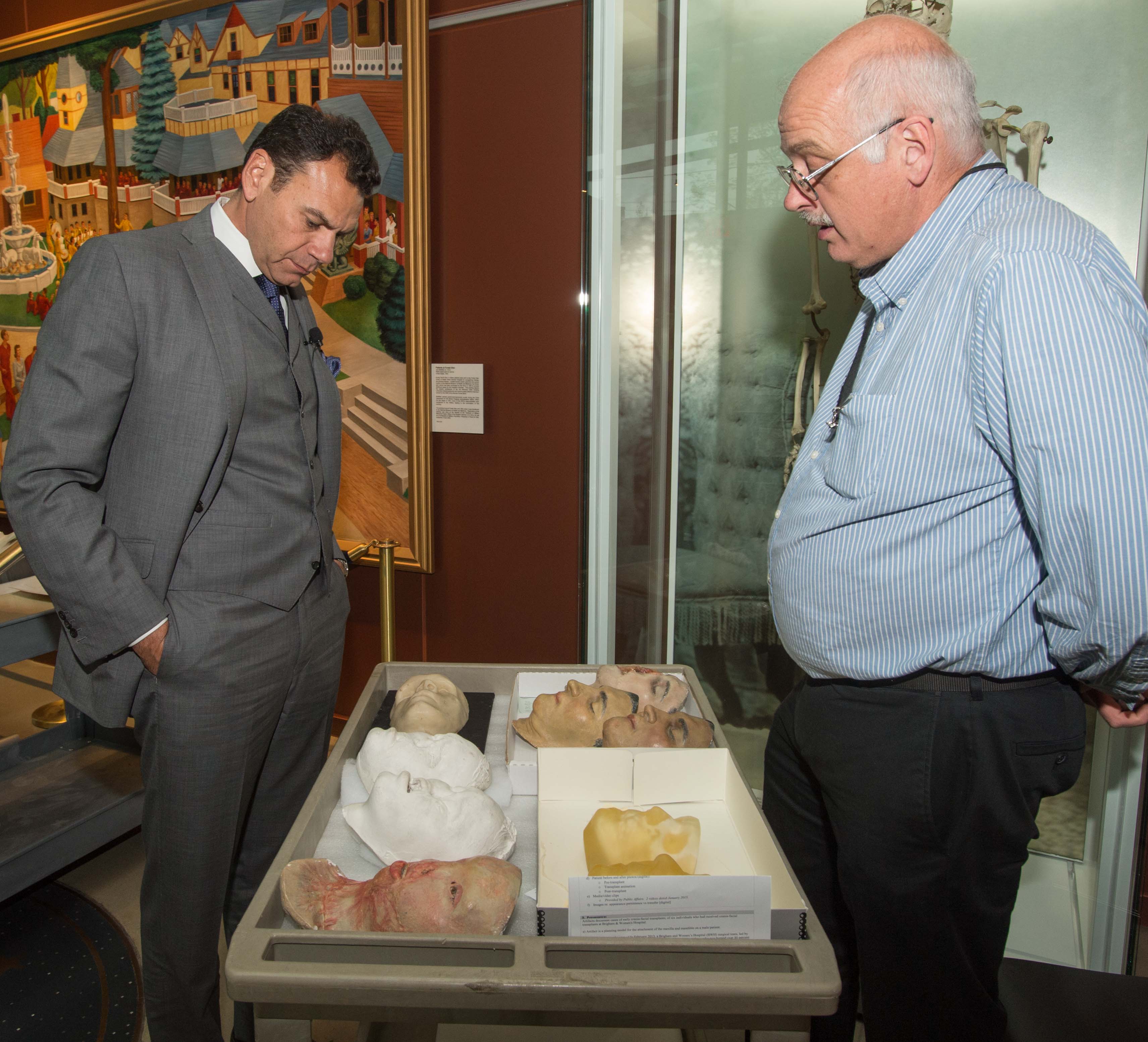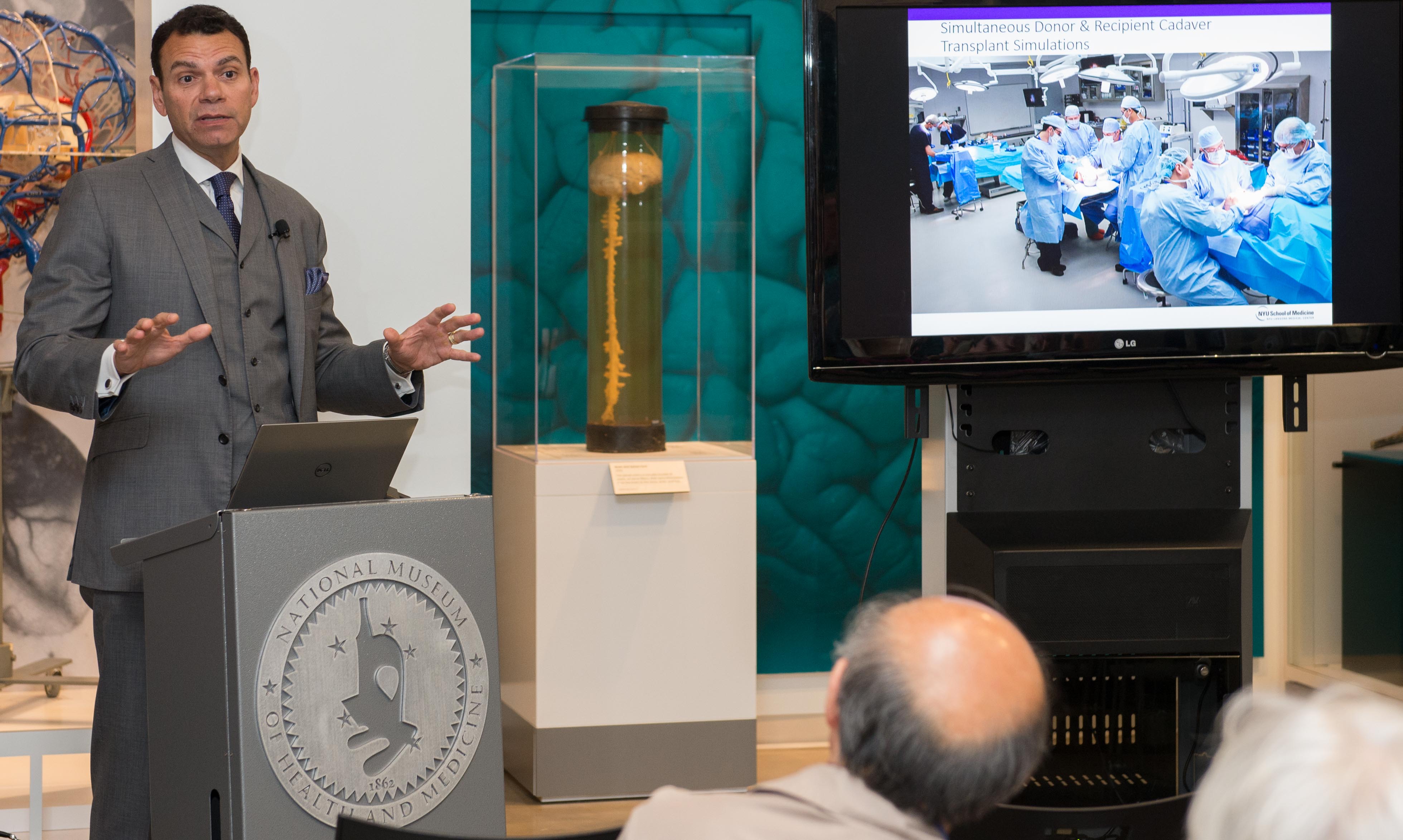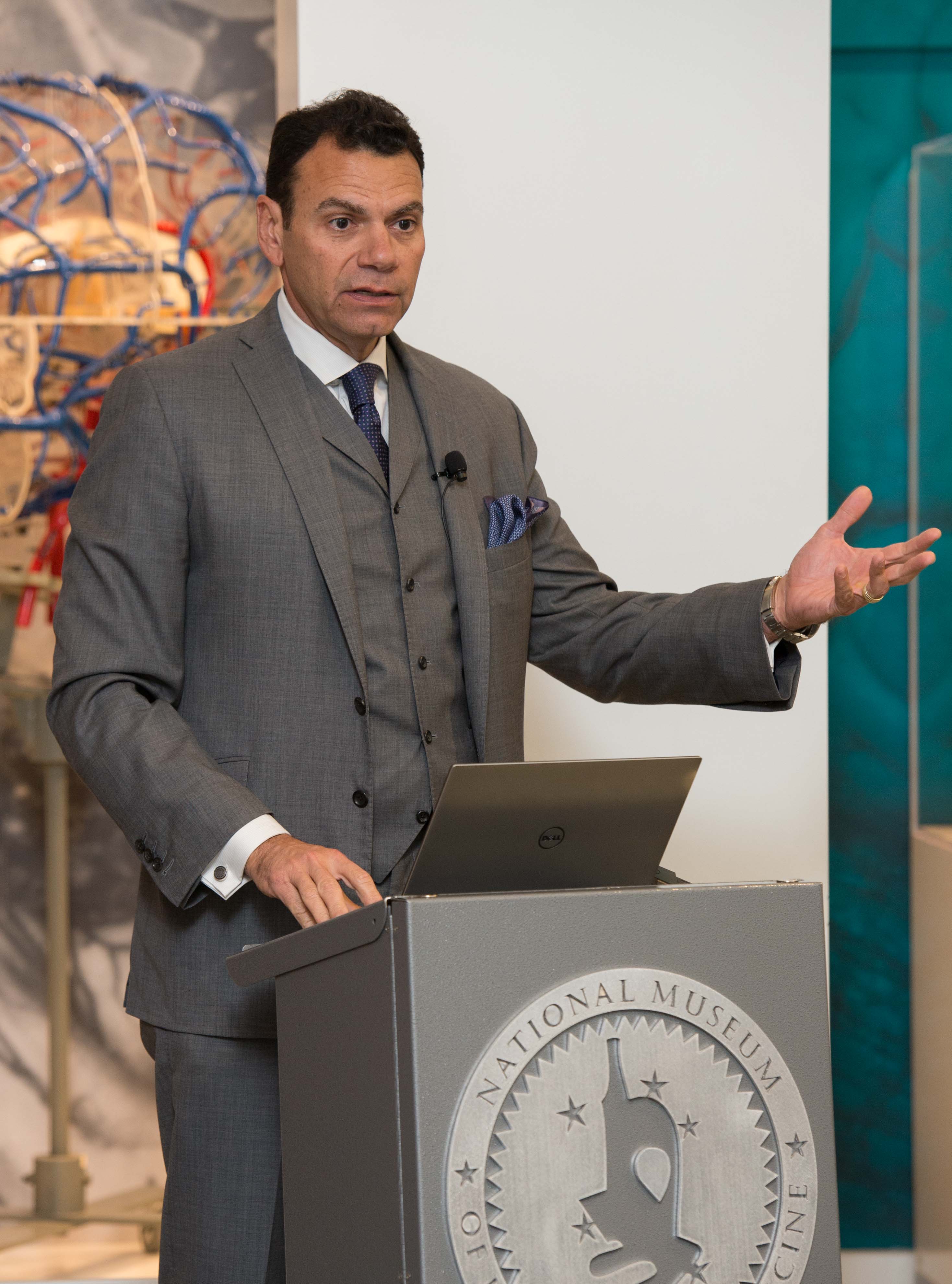Advances in Transplants Benefit Wounded Service Members
By Lauren Bigge
NMHM Public Affairs Coordinator
Research into craniofacial reconstruction surgery for traumatic injury recovery is a top priority for the Department of Defense, as 4,000 service members sustained facial injuries during the wars in Iraq and Afghanistan. As many as 50 service members' facial injuries are catastrophic. With that in mind, the National Museum of Health and Medicine in Silver Spring, Md. invited Dr. Eduardo D. Rodriguez, internationally known for his expertise in plastic and reconstructive surgery, to discuss his experiences at a Medical Museum Science Café on April 25.
NMHM was first introduced to Dr. Rodriguez by Dr. Wendy Dean, medical officer for the Tissue Injury and Regenerative Medicine Program Management Office (TIRM PMO) at Fort Detrick, Md. Dr. Dean has collaborated with NMHM and the Armed Forces Institute of Regenerative Medicine (also at Fort Detrick) on prior public programs and collections activities.
"Dr. Rodriguez brings a comprehensive background in facial reconstruction, exquisite microsurgical technique, and deep compassion to his care of those with catastrophic facial injuries," said Dr. Dean. The TIRM PMO goal is rapid delivery of new solutions from around the world for treating the most severely injured U.S. service members, including regenerative medicine and novel transplantation. Rodriguez's specialties, craniofacial reconstruction and vascular composite allotransplantation, are two of TIRM PMO's seven major focus areas. Dr. Rodriguez, the Helen L. Kimmel Professor of Reconstructive Plastic Surgery, and chair, Hansjörg Wyss Department of Plastic Surgery, and his team at NYU Langone received funding from the Department of Defense to study improvements to the facial transplant surgery. The team is working with civilian and military physicians who may have patients who would benefit from such a transplant.
Dr. Rodriguez treats patients with traumatic injuries due to accidents, disease, and congenital birth defects, including skull abnormalities. "Most patients have functional deficits," he said, noting that deficits may include breathing, speech, eating and drinking, and blinking. The goal is to remove the part of the face that is affected by the injury or abnormality and transplant the skin, tissues, nerves, blood vessels, bones, and teeth that come from the donor.
Thorough planning and practice go into preparation for a facial reconstruction. They use cutting-edge technology and rehearsals with cadavers to prepare. "The importance of planning can never be overstated," Dr. Rodriguez said. "We spend a lot of time refining these cases."
His first human facial reconstruction surgery was a 36-hour operation on 37-year-old Richard Lee Norris at the University of Maryland Medical Center in 2012. Mr. Norris had lost his lips, nose, cheekbones, teeth, jaw and chin in a 1997 gun accident. The losses resulted in minimal movement of his mouth. More than 30 surgeries followed. The transplant Dr. Rodriguez and colleagues performed involved both jaws, teeth, and tongue. Mr. Norris is now able to blink, speak and eat. Dr. Rodriguez showed current photos of Mr. Norris, how he looks after three episodes of tissue rejection, medication, and a timeline of healing.
"The quality of the result is impressive," Dr. Rodriguez said. "It is profound to see Richard's integration into society." Dr. Rodriguez would see another impressive result a few years later, with different colleagues. Dr. Rodriguez now leads the vascular composite allotransplantation (VCA) program, including face and limb transplantation at NYU Langone. In 2015, Dr. Rodriguez led a team of surgeons in a 26-hour procedure on volunteer firefighter Patrick Hardison, 41, who suffered third-degree burns in 2001 when a roof collapsed while he was searching for a victim in a house fire. He lost his ears, lips, eyelids and most of his nose. His recovery has involved nearly 80 operations. Dr. Rodriguez's team transplanted a donor's face onto the bare bones and remaining muscle tissues of Mr. Hardison’s face. More than 100 physicians, nurses, technical staff, and support staff performed the most complex, extensive face transplant to date. The transplant has allowed him to have an independent lifestyle.
Dr. Rodriguez also emphasized the importance of organ donation: "With one donor, we [in the medical community] can save so many lives."
The knowledge Dr. Rodriguez and his colleagues have gained through those reconstructive surgical experiences benefits service members; those who have suffered devastating injuries such as from improvised explosive devices may look forward to new beginnings in life.
"Research comes into play," he said. "This is supported by the Office of Naval Research. It is considered experimental. All of these patients are considered research subjects."
NMHM features an exhibit on innovation in military medicine, and one part of that exhibit details progress in the area of facial reconstruction from the time of the Civil War through the wars in Iraq and Afghanistan. Behind the scenes, museum staff members collect artifacts from military medical research agencies in the areas of clinical and rehabilitative medicine, combat casualty care, and regenerative medicine. Prior to Dr. Rodriguez's presentation, Alan Hawk, manager of Historical Collections at NMHM, featured several related artifacts that are not regularly on display, including masks and molds from severe trauma victims, such as a World War I shell fragment injury of the upper jaw; re-growth of skin after facial burns suffered during World War II, and a World War II soldier undergoing a three-stage facial reconstruction surgery. "The need for reconstruction following a facial trauma is an old problem, and Dr. Rodriguez has a new approach," Mr. Hawk said.
NMHM's Medical Museum Science Cafes are a regular series of informal talks that connect the mission of the Department of Defense museum with the public. NMHM was founded as the Army Medical Museum in 1862 and moved to its current location in Silver Spring, Maryland, in 2012. NMHM is an element of the Defense Health Agency. For more information on upcoming events, please call 301-319-3303 or visit www.medicalmuseum.mil.
Click any photo to view larger version






